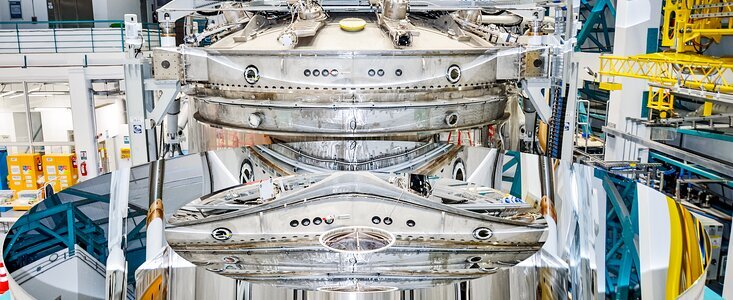14.05.2024
The first reflective coating was applied to Vera C. Rubin Observatory’s 8.4-meter combined primary/tertiary mirror using the observatory’s onsite coating chamber

With its shiny, new silver coating, Vera C. Rubin Observatory’s 8.4-meter primary/tertiary mirror is one step closer to revolutionizing the way astronomers capture and study the Universe. Both mirrors will soon be installed on the Simonyi Survey Telescope where they will collect the light of distant celestial objects and events during the 10-year Legacy Survey of Space and Time (LSST), beginning in 2025.
Vera C. Rubin Observatory, a next-generation astronomical facility under construction in Chile, funded by the U.S. National Science Foundation (NSF) and the U.S. Department of Energy (DOE), achieved an important milestone on 27 April 2024, with the successful coating of the 8.4-meter primary/tertiary mirror with protected silver. This important event paves the way for the installation of the glass mirrors on the Simonyi Survey Telescope, bringing Rubin Observatory closer to revolutionizing the fields of astronomy and astrophysics with its 10-year Legacy Survey of Space and Time (LSST), beginning in 2025.
“This milestone represents not just an incredible feat of engineering, but also an important step towards a transformative new era of scientific advancement” said Edward Ajhar, NSF Program Director for Rubin Observatory.
Rubin Observatory’s one-of-a-kind primary/tertiary mirror is an integral component of the telescope’s optical system, which also includes a 3.4-meter secondary mirror and the LSST Camera, the largest digital camera in the world. Fabrication of the mirror was enabled by major gifts from the Charles Simonyi Fund for Arts and Sciences and from Microsoft founder Bill Gates. The 8.4-meter mirror is made up of two optical surfaces, each with a different curvature, combined into one large structure about as wide as a tennis court. Integrating the two mirrors in this way reduces the engineering and control complexity for the telescope while maintaining its excellent light collecting capacity. The mirror was fabricated over a period of seven years at the Richard F. Caris Mirror Lab, of the University of Arizona, Tucson, AZ, beginning in 2008. In 2015, the completed mirror was moved to a secure storage area and in early 2019 it was shipped to the summit facility on Cerro Pachón in Chile.
The mirror coating process was carried out safely and efficiently by a skilled team using a state-of-the-art, onsite coating chamber built specifically for Rubin Observatory by VON ARDENNE in Deggendorf, Germany. The 128-ton coating chamber, installed on the maintenance floor of the observatory facility, uses a technique called magnetron sputtering to coat mirrors to precise specifications. This technique gives Rubin the flexibility to coat the telescope mirrors with aluminum, silver, or even a combination of both during any coating run. To coat the 8.4-meter primary/tertiary mirror, the lower half of the coating chamber was removed and the mirror’s vacuum-sealed support structure — called the mirror cell — acted as the base of the chamber.
The Rubin coating team, led by Tomislav Vucina, conducted extensive testing to determine the final coating 'recipe' — the precise mixture of elements to make up the coating layers to achieve the best possible combination of reflectivity and durability. To verify the performance of the chosen mixture the team coated a steel stand-in mirror, which has also been used for testing the telescope mount and other observatory components. After confirming the mixture met the defined requirements they repeated the process using the glass mirror.
First, the team applied an adhesion layer of nickel-chromium (NiCr) to the glass mirror blank. Then, they applied the reflective layer of silver (Ag). This reflective layer is incredibly thin — the amount of silver used to coat the entire 8.4-meter surface (64 grams) would form a ball about the size of a cherry tomato. After the application of the reflective layer, the mirror received another NiCr adhesion layer and a final layer of silicon nitride (Si3N4) to protect the reflective coating from dust and other environmental contaminants. “This outer layer needs to be thick enough that it’s not worn off by cleaning,” said Vucina, “but not so thick that it absorbs too many photons and prevents the mirror from meeting Rubin’s scientific requirements.”
The process of coating the mirror took about 4½ hours. After the coating was complete the mirror was moved out of the chamber to a nearby space. To ensure all requirements were met, Vucina and his team conducted a series of tests: reflectivity, adhesion, pinhole, and cosmetic. After analyzing the results of those tests they declared the coating a success. “This was a very well-conducted project from every angle,” said Vucina, “thanks to a combination of careful planning and the technical skills of our excellent team.”
With its dazzling new coat Rubin’s primary/tertiary mirror is an important step closer to capturing light from distant celestial objects. “We’re extremely excited that both mirrors are now coated and will be installed on the telescope very soon,” said Sandrine Thomas, Deputy Director for Rubin Construction. “The combined reflectivity of these mirrors will enable Rubin to detect very faint and far-away objects, leading to great science!”
Quelle: NSF NOIRLab (U.S. National Science Foundation National Optical-Infrared Astronomy Research Laboratory)
